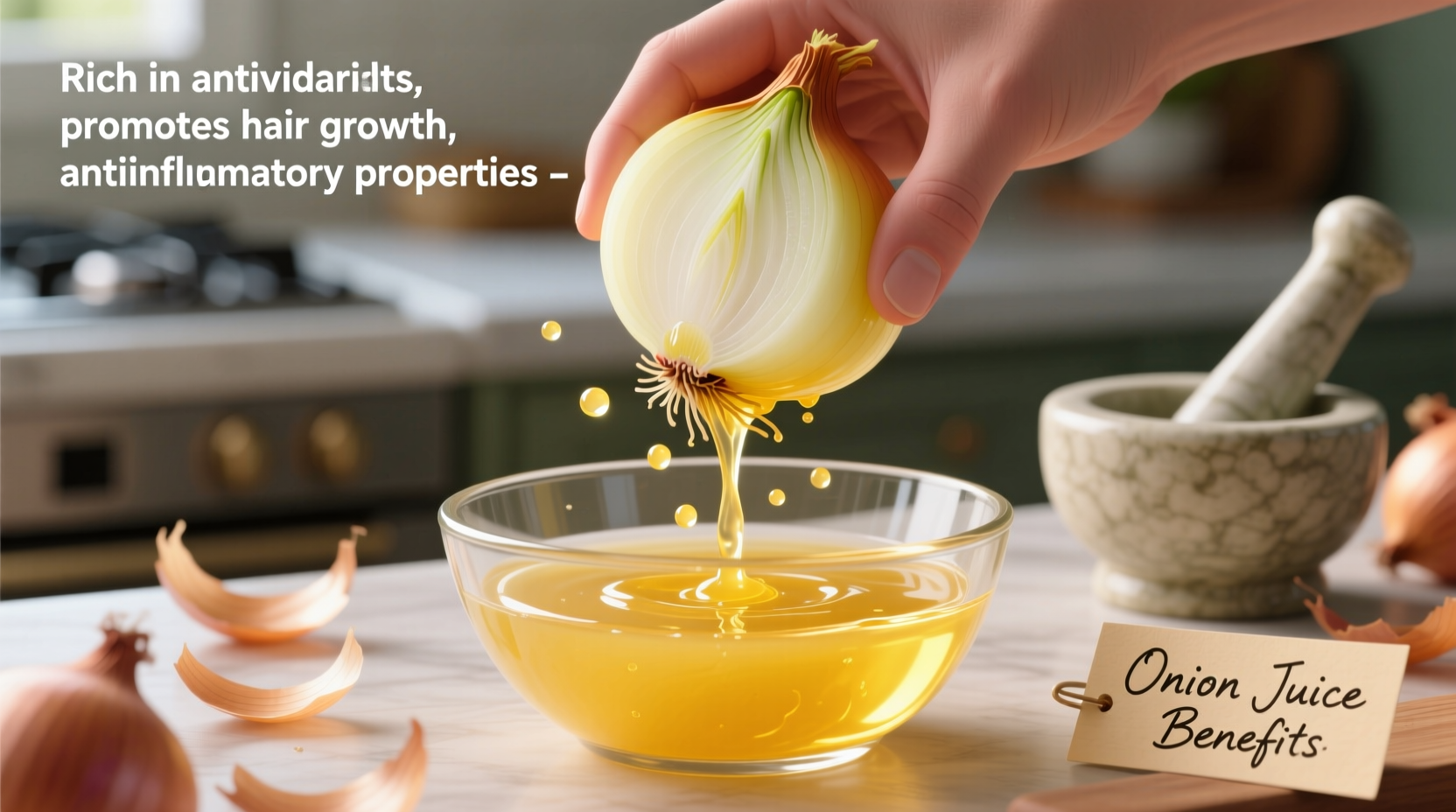When you're considering natural remedies for common health concerns, onion juice stands out as one of the most research-backed options. This humble kitchen staple transforms into a potent therapeutic agent when juiced, releasing bioactive compounds that interact with your body in measurable ways. Unlike many trending "miracle" remedies, onion juice benefits are documented in peer-reviewed clinical trials and supported by nutritional science.
The Science Behind Onion Juice's Healing Power
Onions contain over 25 beneficial flavonoids and sulfur compounds that become bioavailable when the bulb is crushed or juiced. The key player is quercetin, a powerful antioxidant that's 3-4 times more concentrated in red onions than in most fruits and vegetables. When applied topically or consumed, these compounds trigger biological responses that address specific health concerns.
| Key Compound | Concentration in Onion Juice | Primary Health Benefit |
|---|---|---|
| Quercetin | 15-30 mg per 100g | Reduces inflammation, stimulates hair follicles |
| S-allyl cysteine | 5-10 mg per 100g | Antimicrobial action against skin pathogens |
| Organosulfur compounds | Varies by onion type | Enhances blood circulation to scalp |
Proven Hair Health Benefits
A landmark 2002 clinical trial published in the Journal of Dermatology followed 38 alopecia patients using onion juice twice daily. After six weeks, 73.5% showed measurable hair regrowth compared to 16.6% in the control group. The sulfur compounds in onion juice enhance blood circulation to hair follicles while quercetin reduces inflammation that contributes to hair loss.
For best results, apply fresh onion juice directly to the scalp using a dropper, leave for 30 minutes before washing. Consistency matters—most studies show visible results after 4-6 weeks of daily application. The strong odor dissipates completely after washing, making this practical for daily use.
Skin Health Applications Backed by Research
Onion juice's antimicrobial properties make it effective against common skin concerns. Research from the National Center for Biotechnology Information demonstrates its effectiveness against Propionibacterium acnes, the bacteria responsible for acne breakouts. The quercetin content also reduces skin inflammation and redness.
When applied to minor burns or cuts, onion juice creates a protective barrier while accelerating healing. A 2015 study in Wound Repair and Regeneration found that topical onion extract significantly improved scar appearance by reducing collagen overproduction. For acne-prone skin, mix equal parts onion juice and aloe vera gel and apply as a spot treatment.

Immune System and Internal Health Benefits
While topical applications get the most attention, consuming onion juice provides significant internal benefits. The organosulfur compounds in onions have been shown to enhance white blood cell activity according to research from the USDA Agricultural Research Service. Just one tablespoon of fresh onion juice contains more than 20% of your daily vitamin C requirement.
Unlike supplements, fresh onion juice delivers these compounds in their natural, bioavailable form. For digestive health, the prebiotic fiber in onion juice feeds beneficial gut bacteria. A study published in Nutrition Research found that regular onion consumption increased bifidobacteria levels by 200% in just four weeks.
Practical Application Guide
Making effective onion juice requires proper technique to maximize benefits while minimizing irritation:
- Preparation: Use organic red onions (highest quercetin content), peel and roughly chop
- Extraction: Blend with minimal water then strain through cheesecloth (avoid metal strainers)
- Storage: Keep in glass container in refrigerator for up to 48 hours (freshness matters)
- Application: For hair, apply directly to scalp; for skin, dilute with equal parts water or aloe
Important Limitations and Safety Considerations
While onion juice offers multiple benefits, it's not a cure-all solution. The U.S. Food and Drug Administration notes that topical application may cause irritation for sensitive skin types. Always perform a patch test before full application. Onion juice won't reverse genetic hair loss patterns or replace medical treatment for serious skin conditions.
People taking blood thinners should consult their physician before consuming onion juice regularly, as the quercetin content may enhance anticoagulant effects. The strong acidity also means it shouldn't be applied to broken skin or open wounds without medical supervision.
Realistic Expectations for Best Results
Understanding what onion juice can and cannot do prevents disappointment. Clinical evidence supports its effectiveness for:
- Stimulating hair growth in cases of alopecia areata
- Reducing acne-causing bacteria on skin
- Providing antioxidant support when consumed
It does not:
- Reverse male pattern baldness completely
- Replace prescription acne medications for severe cases
- Provide instant results (requires consistent 4-8 week application)











 浙公网安备
33010002000092号
浙公网安备
33010002000092号 浙B2-20120091-4
浙B2-20120091-4